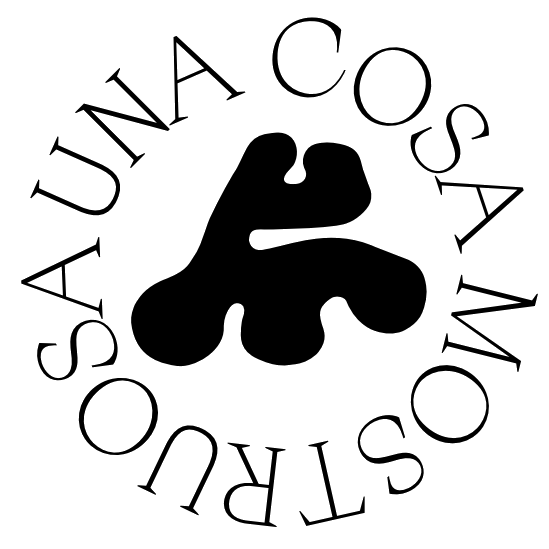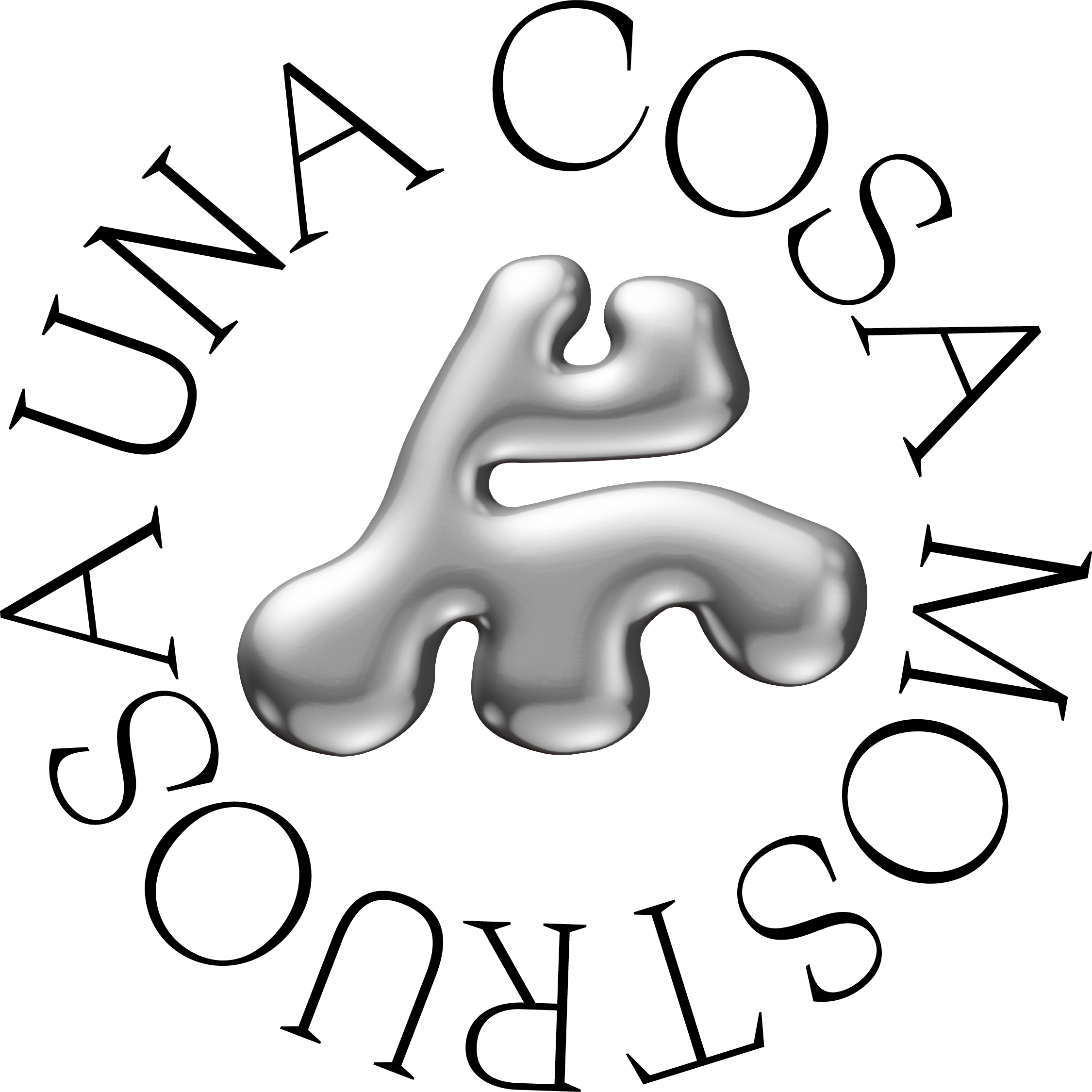About
Una Cosa Mostruosa is a three-dimensional project for the Sacro Bosco di Bomarzo. A sound, narrative and visual odyssey on the cusp between Renaissance Hermeticism and Digital Ecology. Una Cosa Mostruosa has at its core memory as virtuality and space.
Una Cosa Mostruosa takes place on July 17 through a triple intervention: a musical performance by Etrusca 3D (Francesco Cavaliere and Spencer Clark), a visual interpretation by Giulio Scalisi and a guided tour of the Sacro Bosco with Professor Antonio Rocca.
A project by Vittoria de Franchis, realized in collaboration with Giampaolo Scapigliati.

The Theatre of Memory
The intrinsic three-dimensionality of sound, image and word transforms them into vectors of dimensions and catalysts of memory. The latter is a founding element of the Sacro Bosco di Bomarzo, whose deciphering key is to be found in the "L'Idea del Theatro" by Giulio Camillo, a pivotal work of Renaissance Mnemonics and a symbol of the classicist revival of the early sixteenth century. The theater (from the Greek θεάομαι, to see) in this context is understood as a panoramic display of knowledge, an encyclopedia of images. Following the invention of printing and perspective in painting during the Renaissance, images in this historical moment assumed an increasingly central role as a vehicle for transmitting and receiving information, surpassing the logos, which until then held primacy. Giulio Camillo's Theatro suggests a visual mapping of human knowledge, through a series of images called "imagines agentes" (images that generate other images), which populate topical places and summarize in an allegorical way the archetypal concepts of human knowledge. Ideas become works of art and imaginary architectures.
The Theatro represents a spatialization of the memory of humanity, of individual and collective identity: a physical architecture composed of forty-two alcoves, each of which houses an archetypal image. This composition corresponds to a two-dimensional Cartesian reference system, formed by two axes or planes, and results from the intersection of the seven Ptolemaic planets (Moon, Mars, Mercury, Jupiter, Venus, Saturn, Sun) and six archetypal myths. Each myth (Convivio, Antro delle Ninfe, Gorgone, Pasiphae, Talari di Mercurio, Prometeo) symbolizes a phase of the emanation of divine energy from the hyperuranium into the celestial region. A trained memory would have been able to recall the origin of all individual and collective memories. Resuming the classical tradition according to which knowledge, in order not to be violated, was transformed (or codified) into myth, each of these images is veiled, symbolic and needs to be decrypted, interpreted, revealed.
Giulio Camillo was one of the most influential intellectuals of the 16th century Renaissance, a friend of Tiziano (who drew 221 plates for the Theatro) and of Erasmo da Rotterdam, an ambiguous and visionary character, who dedicated his life to the realization of a universal project. The “L Idea of the Theatro” by Giulio Camillo was published posthumously after his death in 1550.
The Theatro represents a spatialization of the memory of humanity, of individual and collective identity: a physical architecture composed of forty-two alcoves, each of which houses an archetypal image. This composition corresponds to a two-dimensional Cartesian reference system, formed by two axes or planes, and results from the intersection of the seven Ptolemaic planets (Moon, Mars, Mercury, Jupiter, Venus, Saturn, Sun) and six archetypal myths. Each myth (Convivio, Antro delle Ninfe, Gorgone, Pasiphae, Talari di Mercurio, Prometeo) symbolizes a phase of the emanation of divine energy from the hyperuranium into the celestial region. A trained memory would have been able to recall the origin of all individual and collective memories. Resuming the classical tradition according to which knowledge, in order not to be violated, was transformed (or codified) into myth, each of these images is veiled, symbolic and needs to be decrypted, interpreted, revealed.
Giulio Camillo was one of the most influential intellectuals of the 16th century Renaissance, a friend of Tiziano (who drew 221 plates for the Theatro) and of Erasmo da Rotterdam, an ambiguous and visionary character, who dedicated his life to the realization of a universal project. The “L Idea of the Theatro” by Giulio Camillo was published posthumously after his death in 1550.

Memory and Digital Ecology
Una Cosa Mostruosa is a bridge between two narrative time frames, the one from the past linked to Renaissance Hermeticism and the contemporary-future one, exploring the role of memory and image in the virtual sphere. Memory, an essential element for the formation of both individual and collective identity, is an essential evolutionary tool, a true technology, which has allowed the transmission of knowledge from one generation to another. Since ancient times, the importance of memory has been theorized and developed by famous thinkers such as Plato, Cicero, Giulio Camillo, Giordano Bruno, Yates, Leibnitz and Hegel. At the origin of mnemonics was the need to remember long speeches in a very accurate way. The concepts to be remembered are placed in a utopian space in the form of visual codes, so that the mental processing of remembering becomes a spacing, a movement through an imaginary landscape scattered with symbols in the shape of architectures, colors, objects, scenes.
Memory is the most intrinsic manifestation of man's capacity for abstraction as a pure demonstration of virtuality. An outflow, often placed on a visual-imaginary level, in a limbo between inside and outside, between individual and context. This projection, which was born as an imagination, has gradually acquired a physical materiality, first with the invention of painting, then of writing, photography and digital memory accumulated in huge data servers. In the contemporary world, memory is completely entrusted to external media, the Internet is littered with archaeological findings, obsolete memories. We are witnessing the passage from memory as an art, as an active practice in which to master, to an almost absolute loss of the ability to memorize. Today, both the action and the choice of what to remember take place in a decreasingly active way, as with computer engineering and digital devices, the automatic storage of information has taken over as well as the idea of a totalizing archive in which everything is potentially stored but not remembered. The accumulation of data-memories is the most evident physical proof of the existence of the online world and its reality: hundreds of square meters of storage occupy remote places on earth, these data centers are mostly underwater and frozen as very powerful cooling systems are needed. Our unconscious accumulation of memory needs to be internalized, transformed and optimized in order to become sustainable.
Una Cosa Mostruosa aims to stimulate a reflection on the process of the transformation of memory intrinsic to the era of digitization and on our relationship with the space of the digital world, commonly thought of as infinite. Just as it was believed, until a few decades ago, that the Earth and its resources were infinite, today we relate to the virtual world without measure. We imagine that in the future, with the saturation of the space available for digital storage, it will be necessary to select which data to "save" and which to forget. If the theory of Eric R. Kandel, a neuroscientist who won the Nobel Prize for Medicine in 2000, is to be believed, "We are what we remember", this selection of memory will be decisive for future identity, both individual and collective. So what will be the chosen memories and, therefore, the new myths of the future?
Una Cosa Mostruosa aims to investigate the nexus between memory and identity, to explore the spatio-temporal transformations of memory, to simultaneously address the issue of the sustainability of the Internet world as an ecology of the digital and the human longing for the divine, for the idea of infinity, which is present in multiple cultures and historical eras.



